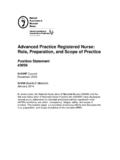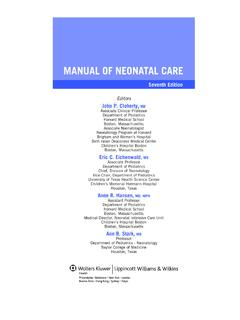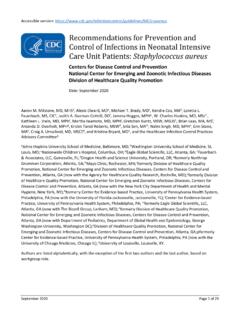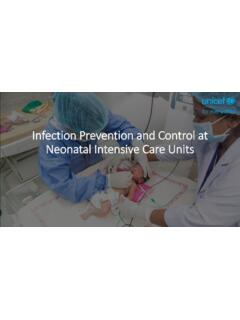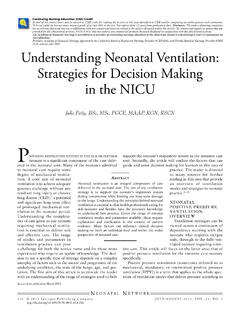Transcription of RN Staffing in the Neonatal Intensive Care Unit
1 RN Staffing in the Neonatal Intensive care unit Position Statement #3061 NANN Board of Directors November 2014 As the professional voice of Neonatal nurses, the National Association of Neonatal Nurses (NANN) recommends that subspecialty Neonatal Intensive care units (Level II, III, and IV NICUs) be staffed with a sufficient number and an appropriate mix of qualified registered nurses to attend to the emergent and complex care requirements of critically ill and convalescent infants. This Staffing should accord with the latest available evidence on achieving safe outcomes for this population. Association Position The delivery of safe and effective Neonatal nursing care requires the assurance of a sufficient number and an appropriate mix of qualified registered nurses (RNs) to attend to the emergent and complex care requirements of critically ill and convalescent infants in subspecialty NICUs (Levels II, III, and IV).
2 Background and Significance The issue of Staffing is not a new one. In Notes on Nursing, Florence Nightingale (1859, p. 59) observed that bad sanitary, bad architectural, and bad administrative arrangements often make it impossible to nurse. She went on to discuss what nursing is and is not, describing elements of care that we consider essential to modern nursing care and Neonatal nursing care : attention to cleanliness, sanitation, warmth, and nutrition. In the ensuing 150 years, health care has become increasingly complex, but nursing care remains the most essential component of that care . Health care continues to evolve. The 2010 Patient Protection and Affordable care Act, commonly called the Affordable care Act (ACA), aims to provide comprehensive health care to citizens of the United States. With the enactment of the ACA have come inevitable changes in the delivery of nursing services.
3 In 2011, the Institute of Medicine (IOM) published The Future of Nursing, which addresses issues facing the profession, including Staffing . A focus on quality of care has been renewed, and many recognize that nursing Staffing issues may negatively or positively affect patient outcomes. Appropriate nurse Staffing is defined as a match of registered nurse expertise with the needs of the recipient of nursing services in the context of the practice setting and situation (American Nurses Association [ANA], 2012, p. 6). Appropriate nurse Staffing is critical to the achievement of safe outcomes. In 2012, the ANA revised its principles of nurse Staffing , delineating eight core components, quoted below: Appropriate nurse Staffing is critical to the delivery of quality, cost-effective health care . All settings should have well-developed Staffing guidelines with measurable nurse sensitive outcomes specific to that setting and healthcare consumer population that are used as evidence to guide daily Staffing .
4 Registered nurses are full partners working with other healthcare professionals in collaborative, interdisciplinary partnerships. Registered nurses, including direct care nurses, must have a substantive and active role in Staffing decisions to assure the necessary time with patients to meet care needs and overall nursing responsibilities. Staffing needs must be determined based on an analysis of healthcare consumer status ( , degree of stability, intensity, and acuity), and the environment in which the care is provided. Other considerations to be included are: professional characteristics, skill set, and mix of the staff, and previous Staffing patterns that have been shown to improve outcomes. Appropriate nurse Staffing should be based on allocating the appropriate number of competent practitioners to a care situation; pursuing quality of care indices; meeting consumer-centered and organizational outcomes; meeting federal and state laws and regulations; and attending to a safe, quality work environment.
5 Cost effectiveness is an important consideration in delivery of safe, quality care . Reimbursement structure should not influence nurse Staffing patterns or the level of care provided. Evidence exists that appropriate nurse Staffing in the NICU is associated with decreased rates of central line associated bloodstream infections (Cimiotti, Haas, Saiman, & Larson, 2006), higher achievement of oxygen saturation goals (Sink, Hope, & Hagadorn, 2011), and reduced risk-adjusted mortality rates (Hamilton, Redshaw, & Tarnow-Mordi, 2007). Specific data for other Neonatal outcome measures are either equivocal or do not exist. Nonetheless, a growing body of evidence suggests that the effect of higher nurse Staffing is strong and consistent in Intensive care units and for surgical patients (Kane, Shamliyan, Mueller, Duval, & Wilt, 2007). Although Neonatal patients have not been studied as a specific population, similar outcomes can reasonably be expected in the Neonatal Intensive care unit (NICU).
6 Specific data analyzing the adequacy of NICU Staffing are scarce. Rogowski and colleagues (2013) measured understaffing relative to acuity-based guidelines. Their data suggested substantial NICU nurse understaffing relative to national guidelines, an understaffing that is higher among high-acuity infants. In this large data set, consisting of 67 hospitals and more than 10,000 infants over 2 years, understaffing was associated with an increased risk of nosocomial infections. Specific clinical situations may be resource Intensive . For example, infants receiving continuous positive airway pressure (CPAP) require meticulous monitoring of their physiologic status in order to prevent undesirable outcomes such as pneumothorax or nasal trauma (Roberts, Badgery-Parker, Algert, Bowen, & Nassar, 2011). Late-preterm infants, who may be physiologically stable, may require considerable attention related to enteral feeding.
7 Supporting breastfeeding throughout all infant gestations can also be quite time Intensive (McGrath, Medoff-Cooper, Hardy, & Darcy, 2010). The Neonatal population is also particularly vulnerable to events requiring emergency measures, including metabolic disturbances, respiratory emergencies, and cardiovascular events. The need for resuscitation can occur at any time during hospitalization, and adequate and appropriate Staffing is required if the necessary care is to be provided. Recommendations Minimum Staffing ratios are sometimes set forth by states. When state guidelines regarding Staffing exist, they must, of course, be followed. NANN makes the following recommendations regarding appropriate RN Staffing of subspecialty NICUs (Levels II, III, and IV). 1. The 2012 ANA s Principles for Nurse Staffing should inform decisions about the Staffing of RNs in units where care is being given to critically ill and convalescent newborns.
8 2. Specific types of patients and clinical situations should dictate specific Staffing ratios. NANN concurs with the recommendations from the Association of Women s Health, Obstetric and Neonatal Nurses (AWHONN, 2010) and the American Academy of Pediatrics and the American College of Obstetrics and Gynecology (AAP & ACOG, 2012) that close evaluation of all factors involved in a specific case is essential for establishing an acceptable nurse-patient ratio. Appropriately qualified RNs in adequate numbers are essential to meet the needs of each infant. 3. NICUs should individualize their Staffing guidelines according to acuity level and skill mix, with the goal of preventing poor outcomes and mortality. 4. Patient acuity tools that have been developed and validated, or are site specific, should guide decisions about the Staffing resources needed to care for newborns with special needs ( , infants on CPAP, late preterm infants who may require considerable time in feeding).
9 5. In situations involving Neonatal specialty care for fewer than 6 intermediate- care patients or 4 or fewer Intensive care patients, a minimum of two RNs with Neonatal expertise and training is required. Conclusions The issue of professional RN Staffing in the NICU is complex. The patient-acuity assessment and the professional nursing skill mix are important components of local Staffing decisions. High-quality care and safe outcomes should be the overall goals of Staffing . Facilities that care for newborns should evaluate nurse Staffing sensitive outcomes to evaluate the appropriateness of their Staffing plans. References American Academy of Pediatrics & American College of Obstetricians and Gynecologists. (2012). Guidelines for Perinatal care (7th ed.). Elk Grove Village, IL: AAP; Washington, DC: ACOG. American Nurses Association. (2012). ANA s Principles for Nurse Staffing (2nd ed.)
10 Silver Spring, MD: Author. Association of Women s Health, Obstetric and Neonatal Nurses. (2010). Guidelines for Professional Registered Nurse Staffing for Perinatal Units. Washington, DC: Author. Cimiotti, J. P, Haas, J., Saiman, L., & Larson, E. L. (2006). Impact of Staffing on bloodstream infections in the Neonatal Intensive care unit . Archives of Pediatric and Adolescent Medicine, 160(8), 832 836. Hamilton, K. E., Redshaw, M. E., & Tarnow-Mordi, W. (2007). Nurse Staffing in relation to risk-adjusted mortality in Neonatal care . Archives of Disease in Childhood: Fetal and Neonatal Edition, 92(2), F99 F103. Institute of Medicine. (2011). The Future of Nursing: Leading Change, Advancing Health. Washington, DC: National Academy Press. Kane, R. L., Shamliyan, T., Mueller, C., Duval, S., & Wilt, T. (2007). Nurse Staffing and quality of patient care (Evidence Report/Technology Assessment No.)

